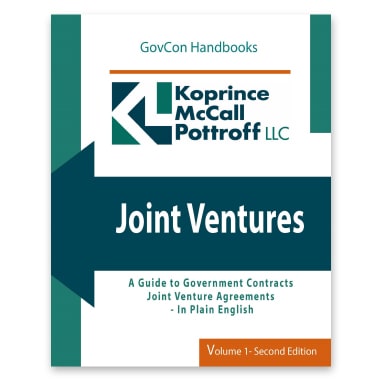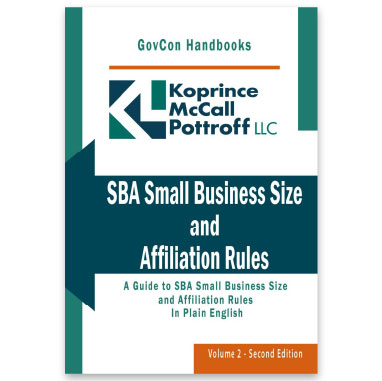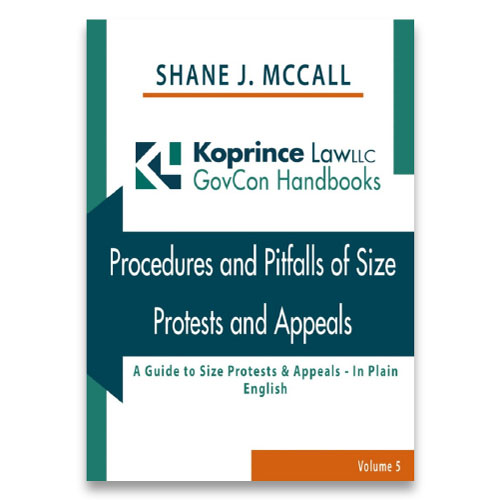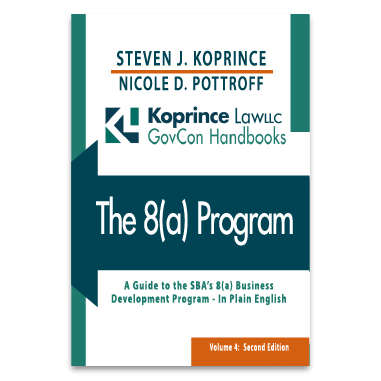Legal news and notes for small government contractors
Published by Koprince McCall Pottroff LLC | Edited by Shane J. McCall
Back to Basics: Teaming Agreements
Posted on March 9, 2023 by Nicole Pottroff
Print Article
Teaming agreements are a great tool for establishing the prime-subcontractor relationship to jointly pursue government contracts. They can protect the parties’ rights, set performance expectations, demonstrate regulatory compliance, and reduce the likelihood of disputes down the line. But no matter how common teaming agreements have become, many still find them to be a bit of a mystery. This is probably because teaming agreements are neither required nor defined by SBA’s regulations or the FAR; and they have no regulatory-required content. But that doesn’t stop procuring agencies from requiring submission of teaming agreements with proposed teaming partners (especially where the offeror requests consideration of its proposed subcontractor’s past performance, experience, and/or capabilities). So, it is beneficial to know some of the “basics” of teaming agreements: what they are, why you should have one, and what should be included.
What is a teaming agreement?
We will start with the very basics. What is a teaming agreement? Well, again, we don’t have a nice SBA or FAR citation to give you here. The FAR does talk a little bit about government contracting teaming arrangements in general (distinguishing between between joint venture teams and prime-subcontractor teams). But that is about it. So, we will discuss some common industry understandings regarding teaming agreements to answer this question, instead.
Generally, “teaming agreement” is the term used to describe an agreement between the prime contractor offeror on a government contract and their proposed subcontractor. You can think of a teaming agreement as the “chasing the contract” document–which can be contrasted with the subcontract agreement or the “performing the contract” document.
Typically, the teaming agreement comes first, governing the parties’ relationship as they pursue a government contract as a proposed prime-subcontractor team. Then, if the proposed prime is awarded the prime government contract, a subcontract agreement will replace the teaming agreement; and it will govern the parties’ relationship in performance of that contract.
Now, as I mentioned earlier, just because government contracting regulations don’t require a teaming agreement or dictate its contents, doesn’t mean you should brush over the idea of having a teaming agreement. Indeed, the benefits of having a (well written) teaming agreement are vast. And some procuring agencies actually require them in certain situations. Let’s dig into some of the reasons why you should consider using a teaming agreement as a precursor to your subcontract agreement.
Why should I have a teaming agreement and what should it include?
As discussed briefly above, one reason you should have a teaming agreement while bidding on government contracts is that, more and more often, we are seeing procuring agencies requiring them. Many times, the agency will require submission of a teaming agreement with a proposed subcontractor where the proposal relies on that subcontractor’s capabilities, past performance, or experience. This could be a situation where the proposed subcontractor will be providing a specific administrative system, certain personnel, etc. (so long as the solicitation allows it). Or it could be one where the past performance examples are coming from both the proposed prime and proposed subcontractor (again, provided such is consistent with the solicitation).
And sometimes, agencies will require submission of teaming agreements with all proposed subcontractors, regardless. Agencies are well aware of the impact subcontractors can have on contract performance–as well as the importance of subcontracting for small and disadvantaged businesses (that may not otherwise be able to meet government needs).
In any event, agencies may use teaming agreements to evaluate the proposed prime-subcontractor relationship for several reasons, which may include (but are certainly not limited to):
- To make sure the parties’ proposed responsibilities meet all the solicitation’s requirements;
- To determine whether a proposed subcontractor will perform “major or critical aspects” of the solicitation where the proposal relies on such subcontractor’s past performance;
- For set-aside contracts, to check that the parties’ proposed division of work is consistent with any applicable limitations on subcontracting and/or performance of work requirements;
- For set-aside contracts, to ensure that the prime will be performing the “primary and vital” work under the solicitation and will not be “unduly reliant” on a subcontractor for performance (also known as an evaluation under the ostensible subcontractor rule); and
- To examine the level of commitment regarding the proposed subcontract (i.e., whether the prime guarantees award of a subcontract to the proposed subcontractor upon award of the prime contract).
It follows naturally from the above list (the reasons why an agency may review a teaming agreement), that a well-written teaming agreement would likely include the following terms:
- A detailed list of the parties’ responsibilities for proposal preparation and submission. Having a well-defined explanation of each party’s proposal responsibilities can provide the agency with important information about the parties’ compliance with certain potentially applicable regulations (i.e., where the subcontractor takes the lead on proposal drafting and submission, it may raise red flags regarding the ostensible subcontractor rule or even the limitation on subcontracting). But it also benefits the parties to set concrete expectations at the outset of the prime-subcontractor relationship (for obvious reasons). As such, a well-written teaming agreement will detail each party’s specific responsibilities for the preparation and submission of proposals, making sure the solicitation and submission requirements are met.
- A detailed explanation of the proposed subcontractor’s scope of work. Indeed, a well-written teaming agreement will detail the subcontractor’s scope of work under the resulting contract, including: how much work the subcontractor will get; what specific portions of the work the subcontractor will be performing upon award; and (where possible) which equipment, resources, and labor each party will provide under the contract and what each party’s specific performance responsibilities will be (where the contract is undefined or indefinite, this should, at a minimum, include each party’s generally anticipated role in contract performance). Doing this can help demonstrate to the agency that all the contract’s requirements will be met–and who will be meeting them. Again, this allows the agency to determine whether the parties’ proposed division of work is consistent with SBA’s affiliation and subcontracting regulations (if applicable), as well as the significance of the proposed subcontractor’s role (where necessary to rely on subcontractor past performance in the proposal). But working out the details of the subcontractor’s scope of work in the teaming agreement does not just benefit the agency; it is also hugely beneficial to the parties themselves. It may help to reduce the likelihood of confusion and post-award disputes later on regarding who is supposed to do what. Where the parties don’t have a teaming agreement detailing their anticipated responsibilities and roles for contract performance, we more often see post-award conflicts, such as the proposed subcontractor feeling they were “supposed” to get a certain amount and/or type of work, and did not fairly get it in the end.
- A provision establishing the certainty of the subcontract agreement (or lack thereof). Again, some agencies will look at the teaming agreement to determine what level of certainty the parties have that the proposed subcontractor will be awarded a subcontract if the prime contractor is awarded the prime contract. But it is also very important for the parties themselves to establish an agreement up-front, in this regard. Sometimes, the teaming agreement will guarantee a subcontract award to the subcontractor if and when the prime contract is awarded to the prime contractor (i.e., “A subcontract shall be awarded to Teammate within five days of award of the Prime Contract.”). Other teaming agreements will be more flexible, sometimes giving the prime contractor the right to decide if award to the subcontractor is in its best interest. There isn’t a right or wrong answer here; but again, the parties should make sure everyone is on the same page, and including such a provision in the teaming agreement is a great way to do that.
Again, the suggested provisions above address both most agencies’ primary reasons for teaming agreement reviews and some best practice considerations, as well. To round out our discussion of teaming agreements, we will cover a few more best practice provisions–this time–a bit more focused on the relationship between the parties. As such, a well-written teaming agreement may also include the following terms:
- Plan for Prospective Subcontractor’s Payment. One of the most common types of post-award dispute we see between prime contractors and subcontractors is in regard to payment. As such, where the parties can establish payment expectations up-front, in the teaming agreement, they can help minimize the risks of payment disputes later on. Wherever possible, a teaming agreement should include payment provisions that: cover the anticipated contract’s pricing structure (i.e., Firm Fixed Price, Time & Materials, etc.); set a specific pricing structure for the subcontract; and list all rates, product pricing, and any other relevant payment terms for the subcontract.
- Confidentiality/Non-Disclosure Terms. It is pretty standard in most contracts for various teaming arrangements to have some confidentiality or non-disclosure terms. And I probably don’t need to explain why such terms are important. But for teaming agreements, specifically, such terms should take into consideration the parties’ exchange of potentially confidential or proprietary pricing and past performance information, which is common in proposal preparations. Additionally, such terms should generally be fair–with equal protections for each party’s confidential or proprietary information. Finally, such terms should also include the exception for the FAR’s whistleblower requirements (at FAR 52.203-18 and FAR 52.203-19), allowing employees and subcontractors to lawfully report waste, fraud, and abuse related to any government contracting. Sometimes, the parties will chose to have a separate non-disclosure agreement (typically one which will govern their entire relationship and be incorporated by reference into both the teaming agreement and any resultant subcontract). And that is fine. But we still suggest it incorporate the considerations and terms discussed here.
- Exclusivity (or Non-Exclusivity) Provisions. Outside of a few restrictions in the improper business practice provisions of the FAR, it is really up to the parties how exclusive they want to be (in regard the solicitation, type of work, procuring agency, etc.). But one thing is certain, establishing the exclusivity expectations for the subject solicitation up front, in the teaming agreement, can help prevent disputes and heartbreak later on. Thus, the teaming agreement should cover (at a minimum): whether the subcontractor must bid exclusively with the prime (as opposed to being able to bid with other primes); and whether the prime may consider other potential subcontractors for the specific work the proposed subcontractor plans to perform (or for other, related work, under the contract).
- Termination Provisions. All good things must come to an end, right? For teaming agreements, it is important that the parties establish up front when the agreement will terminate and what events will trigger termination. This can be especially important where there are exclusivity provisions in the teaming agreement (discussed above). Some examples of events that may trigger termination of a teaming agreement are: (1) execution of the subcontract; (2) the parties can’t agree on a subcontract despite good faith negotiations (sometimes, within a specific time frame); (3) the government doesn’t approve of the subcontract/subcontractor; (4) the prime decides not to submit a proposal for the solicitation; (5) another prime is awarded the contract under the solicitation (sometimes, considering potential protests and extending termination to resolution of such); and (6) the default or material default of either party. Finally, it is wise for the parties to determine whether they want a termination for convenience clause and whether/what kind of notification is required for such termination.
Teaming up for government contracts can be extremely beneficial–for the team members and for the government client. Being able to utilize the experience and capabilities of multiple contractors instead of just one can open the door to many opportunities that may otherwise be off the table for some small and disadvantaged businesses–especially in the highly competitive world of government contracting. And the government client can certainly benefit from a qualified small business offeror with the ability to properly utilize the skills and know-how of its subcontractors. But it goes without saying, teaming can go very right or very wrong for government contractors. And one of the surest ways to encourage the former is to make sure the parties are on the same page with regard to expectations, responsibilities, rules, and obligations–up front. Having a thorough and well-written teaming agreement can do just that.
If you have specific questions about teaming agreements, teaming in general, or if you need help with another government contracting legal issue? Email us or give us a call at 785-200-8919.
Looking for the latest government contracting legal news? Sign up here for our free monthly newsletter, and follow us on LinkedIn, Twitter and Facebook.
This entry was posted in Back to Basics and tagged Limitations on Subcontracting, ostensible subcontractor rule, Subcontracting, subcontractor's past performance, subcontractors, teaming, teaming agreements, teams. Bookmark the permalink. Nicole Pottroff Partner Koprince McCall Pottroff LLC 785-200-8919 Email
Contact Us
- 785-200-8919
- info@koprince.com
- www.koprince.com
Twitter
Top Topics
- 8(a) Program
- Back to Basics
- Claims and Appeals
- Common Misconceptions
- COVID-19
- Events
- FAA ODRA Decisions
- Federal Government Contracting
- Five Things
- GAO Bid Protests
- GovCon Voices
- HUBZone Program
- NAICS Code Appeals
- PPP
- PTAC Spotlight
- Reports
- SBA OHA Decisions
- SBA Size Protests
- Service-Disabled Veteran-Owned Small Businesses
- SmallGovCon Week In Review
- Statutes and Regulations
- Suspension Debarment and Penalties
- U.S. Court of Federal Claims
- Uncategorized
- Why File
- Women Owned Small Business Program
- You Tube Tuesday
Handbooks
 Available in paperback and on Kindle
Available in paperback and on Kindle  Available in paperback and on Kindle
Available in paperback and on Kindle  Available in paperback and on Kindle
Available in paperback and on Kindle  Available in paperback and on Kindle
Available in paperback and on Kindle
Contact Us
- 785-200-8919
- info@koprince.com
- www.koprince.com
Contributors
- 785-200-8919
- info@koprince.com
- www.koprince.com
This blog is for educational purposes only. Nothing posted on this blog constitutes or substitutes for legal advice, which can only be obtained from a personal consultation with a qualified attorney. Using this blog does not create an attorney-client relationship between you and the authors and/or Koprince McCall Pottroff LLC. Although the authors strive to present accurate information, the information provided on this blog is not guaranteed to be complete, correct or up-to-date. The views expressed on this blog are solely those of the authors and do not necessarily reflect the views of Koprince McCall Pottroff LLC.
Copyright © 2024 Koprince McCall Pottroff LLC • Website by Flint Hills Design • Log in

 Available in paperback and on Kindle
Available in paperback and on Kindle  Available in paperback and on Kindle
Available in paperback and on Kindle  Available in paperback and on Kindle
Available in paperback and on Kindle  Available in paperback and on Kindle
Available in paperback and on Kindle Available in paperback and on Kindle
Available in paperback and on Kindle  Available in paperback and on Kindle
Available in paperback and on Kindle  Available in paperback and on Kindle
Available in paperback and on Kindle  Available in paperback and on Kindle
Available in paperback and on Kindle